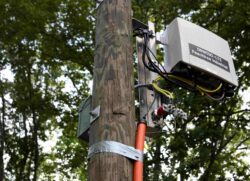 Oct 1, 2019: We are seeing applications for Small Cells in our portfolio of sites. Unfortunately, the offer is for $200 a month. This is substantially lower than the traditional macro cells. The standard offer is for a small cell installation is a 50-foot wooden pole to be erected somewhere on the property with practically all the equipment attached to the pole, with exception to some utilities. However, rent is not based on square foot of space occupied alone. It is a function of access and utility easements, plus a degree of intrusion of privacy to a home or business. Traditionally, macro sites (traditional sites that provide general cell coverage for much of the population today) pay $1,000 and up (depending on many factors). Wireless carriers, through their contract leasing agents, will argue that the impact to your land is minimal thus warranting low rent rates. Quietly, contract leasing companies have confided in us that they are having tremendous difficulties in convincing landlords across the country to accept $200 rents because the infrastructure and maintenance requirements of the electronics do not change, thus making small cell deployments massively difficult on private properties. If you have been contacted to place a small cell on your property for $200 a month, know that this is a rent compensation paradigm shift that the carriers are trying to affect nationwide, albeit unsuccessfully.
Oct 1, 2019: We are seeing applications for Small Cells in our portfolio of sites. Unfortunately, the offer is for $200 a month. This is substantially lower than the traditional macro cells. The standard offer is for a small cell installation is a 50-foot wooden pole to be erected somewhere on the property with practically all the equipment attached to the pole, with exception to some utilities. However, rent is not based on square foot of space occupied alone. It is a function of access and utility easements, plus a degree of intrusion of privacy to a home or business. Traditionally, macro sites (traditional sites that provide general cell coverage for much of the population today) pay $1,000 and up (depending on many factors). Wireless carriers, through their contract leasing agents, will argue that the impact to your land is minimal thus warranting low rent rates. Quietly, contract leasing companies have confided in us that they are having tremendous difficulties in convincing landlords across the country to accept $200 rents because the infrastructure and maintenance requirements of the electronics do not change, thus making small cell deployments massively difficult on private properties. If you have been contacted to place a small cell on your property for $200 a month, know that this is a rent compensation paradigm shift that the carriers are trying to affect nationwide, albeit unsuccessfully.
May 2016: Just this week, CommScope announced that national wireless carriers have committed to “an extensive deployment” of its small cells in small to medium-sized business locations. The deployment is part of the carriers’ network densification plan, which the companies continue to pursue both for LTE services and in advance of 5G. The cells are based on Qualcomm FSM small and Qualcomm VIVE Wi-Fi chipsets and support both 2.5 GHz TD-LTE and 802.11ac dual-band, dual-concurrent Wi-Fi.
May 2016: 1. Small cells are a crucial part of Sprint’s strategy to improve its network while cutting some of the costs associated with traditional macrocells. “When you’re poorer than the rest (of the carriers), when you have less money, you’re going to deploy your network” in different ways, Sprint CEO Marcelo Claure said during a conference call with media representatives following the carrier’s quarterly earnings release this week. “We’re a lot smarter in how we’re deploying our network,” Claure continued, saying the carrier has begun to employ a “site by site” strategy. “We’re not going to the tower companies and signing a 20-year agreement if there’s no need.”
March 2016: In 2016, the wireless industry is ramping up the deployment of Small Cells on utility poles where rent can be as low is $60 per month. We know from our insider knowledge that when these small cells are fully operational later 2016, there will be less dependencies on macro (big) cell sites. See how Sprint uses Small Cells in its network.
March 2016: See hundreds of Engineering positions posted by wireless carriers looking for Small Cell engineers. Just Google “Small Cell wireless engineer” and you will see the tremendous demand for Small Cell RF Engineers. This is real. 2016 is the year of Small Cell buildouts.
Categorised in: Blog
This post was written by Larry Heuchert
